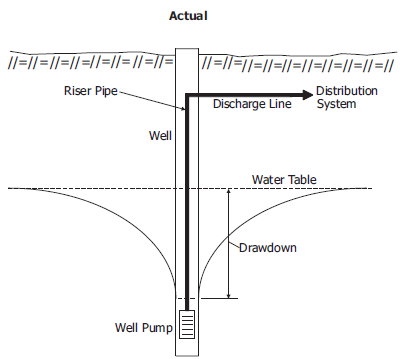

In this study, The SarzeRezvan Plain is one of the most important plains of Hormozgan Province (Iran) for agricultureandfresh water supply. The research results showed that, in general, developments of urban and agricultural lands are the main causes of recharge reduction in their study area. Paul combined MODFLOW and WETPASS models to study land use effect on discharge and recharge of groundwater in eastern China.
Well drawdown predictions code#
They used GIS to produce thematic layers and the MODFLOW-2001 code to estimate the effects of recharge on hydrogeological system piezometricbehaviors. Chenini and Ben Mamou used GIS and numerical modeling to identify suitable sites for artificial recharge and development of underground water resources in Central Tanzania. The researchers used the PEST model to estimate hydrodynamic coefficients and aquifer recharge values during different periods and simulated the direction ofgroundwaterflow. They used monthly data from 157 drinking water wells. Thorley and Callander have simulated groundwater using the MODFLOW model in Christchurch, New Zealand. They in order to combined surfacewater model with the MODFLOW model. Several studies have been performed worldwide that used the MODFLOW model for various fields of aquifer management.Rayne et al have simulated urban underground waterof Estrogen Bay(Wisconsin, USA) and determined the recharge place of fresh water wells in that area.Ramireddygari et al have examined the structural effects of basin and irrigation on groundwater levels to study the interaction between rivers, aquifers. MODFLOW is athree-dimensional model that simulates flow in non - homogeneous,non – isotropicsaturated and unsteady porous environments. One of the mathematical models that simulate aquifer behavior is the MODFLOW model. Due to thehighability of ground water simulation models to be adapted to an aquifersystem and the ability of these models to predict, they provide favorable conditions for groundwater management. In order to predict the effects of recharge and discharge on the water table, the aquifer can be simulated. Management of groundwater resources requires accurate understanding of aquifer performance under current conditions, and predicting the impacts of recharge and discharge. This requires serious, scientific management of groundwater resources. On the other hand, technology development has caused rapid increase in water use, with a decline in the water table level. Introduction Today, depletion of water from aquifers that are the second largest source of freshwater in the world, has created a serious challenge for most countries. The results of the model prediction have shown that if pumping is going to be constant for 8 years, the drawdown will be approximately 10.56 m, after 8 years.ġ. Therefore, this model was used to predict the aquifer drawdown. The Root Mean Square Error (RMSE) between observed and calculated (by the model) water head is 0.854, which indicates excellent agreement with the aquifer’s natural condition. Water head data from April to September 2011 has been used for verification. The PEST computational code was used for calibration. To simulate the change in water head under unsteady state, we used water head data from 2001-2010. After having proven an excellent match between the generated model and the aquifer’s natural condition, we used this model to predict the aquifer drawdown. In this study, we have used the MODFLOW model to simulate the SarzeRezvan Aquifer. The use of mathematical models is one important tool to predict the status of an aquifer drawdown.

Prediction of aquifer drawdown is necessary for the correct management of an aquifer.


 0 kommentar(er)
0 kommentar(er)
